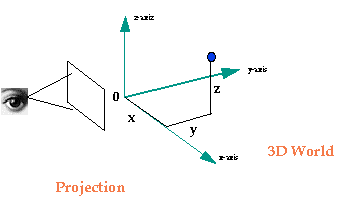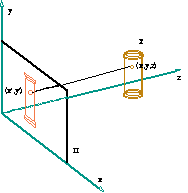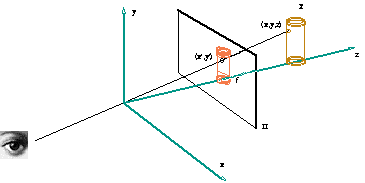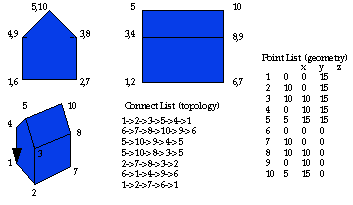
Introduction to Computer-aided Architectural Design 3D
To mail questions or comments please click here
3D Space - Concepts of modeling
Contents
1. The Concept of Three-dimensional Space
The concept of three-dimensional space is very old and very simple. By
observation one can notice that the world around us is comprehensable by
simply watching at it. Although there is a material existence of objects
(molecules, atoms, etc.) nonetheless it is enough to use our eyes to locate
objects. We do not have to physically touch objects to locate them. The
eye is a piece of glass where rays from the real world are projected. Therefore
we can distinguish two systems: a three-dimensional world, and a
projection system. Historically, Euclid was able to specify the existence
of such a world, Descartes was able to specify a system of three-directions
to locate objects within such a wolrd, and others were able to develop techniques
to project that world on a canvas.

With the development of computer technology it became interesting and
challenging to simulate the way humans see the world. The computer screen
would be the surface of the eye, the 3-D world would be defined as x,y,z
numbers in the computer's memory, and the projection calculations would
be done with the computer processor. Lets take an example: a cube has eight
points, and each point has three coordinates (x,y,z), therefore we need
8x3=24 numbers to describe the position of all points of the cube. Using
simple mathematics we can calculate the projections of each point on the
computer screen and then draw the projected cube on the screen. If we change
the coordinates (move, rotate, or scale the cube) we project the points
from their new position on the screen.
In the following figures you can see the projection of an object with parallel lines and converging lines. The first projection system is called orthographic or parallel and the second is called perspective.


Lets go back to simple geometry. An object can be composed of points
and connecting lines. A square is four points and four connections. A cube
is eight points and 12 connecting lines (we can also refer to the points
as the geometry of the object and the connecting lines as the topology
of the object). In the following example there are 10 points and 7 connecting
line lists each for every face. This is essentially how an object is represented
internally as lists of numbers in the computer's memory. In addition to
this information one can add attributes such as color, material, etc.

Three-dimensional objects can be created in many different ways:
As mentioned earlier, three-dimensional objects are stored in the computer's memory as numbers representing points and connections. Then these points are projected to the surface of the screen. Any change in the geometry (that is, the location of the points) is called a transformation. In the figure below each point of the object was multiplied by a series of sines and cosines resulting in creating the impressionof rotation.

We distinguish many transformations, but the most important are:
Translation
Translation is another word for moving and object to a new position. It also sometimes called offsetting. Basically, it is the change of location of the object in space. By adding a constant number (i.e. 5 units) to the x coordinate of all points the object is moved in the x direction (by 5 units).

Rotation
A rotation specifies a pivoting, or angular displacement about an axis. Objects are rotated by specifying an angle of rotation and a pivot point. Then trigonometric functions are used to determine the new position.

Scale
Scale (or sizing) either reduces or enlarges an object. Objects are scaled by specifying a percentage of scaling, the direction, and a pivot point. Then simple multiplication of each coordinate determines the new position.

Set operations are logical combinations of objects. They behave as if the objects have mass. Imagine two object that are composed of molecules. The AND operator defines a new object that combines all the molecules of object A AND object B. To be more specific:
Union
For two objects A and B the union operator defines a new object that combines all the molecules of object A AND object B.
![]()
Intersection
For two objects A and B the intersection operator defines a new object that combines all the molecules that are common to object A and B.
![]()
Difference

References